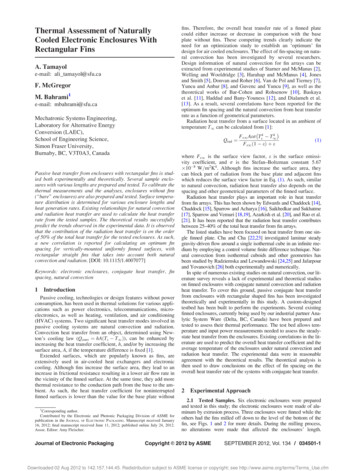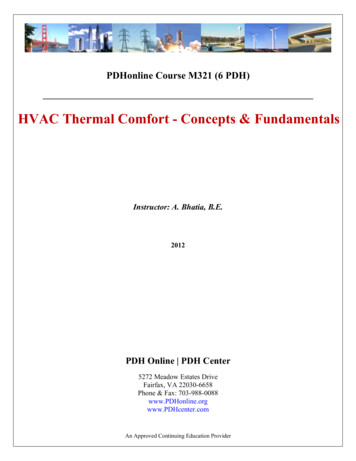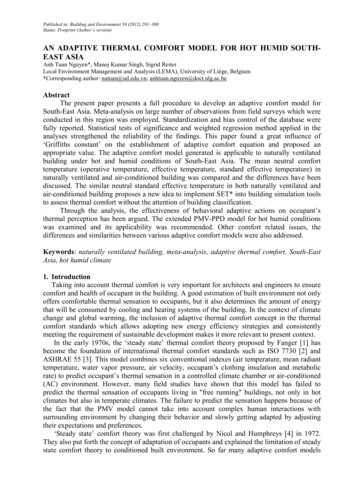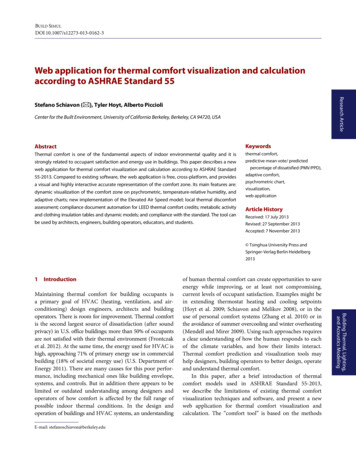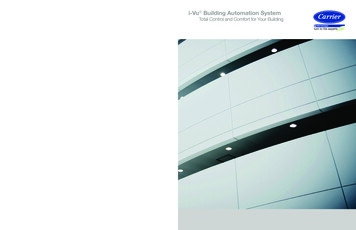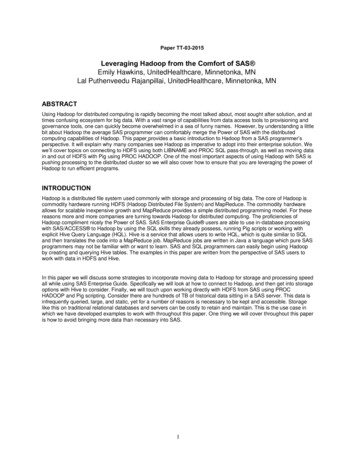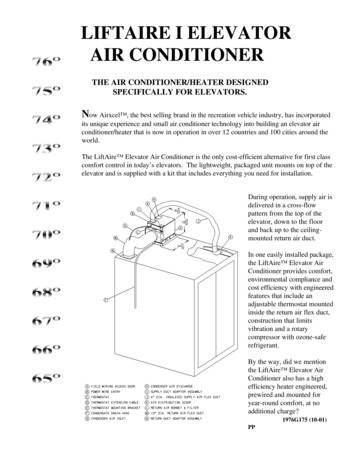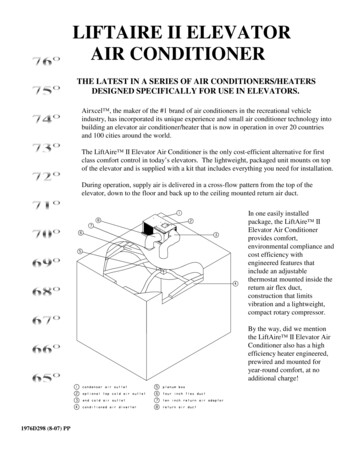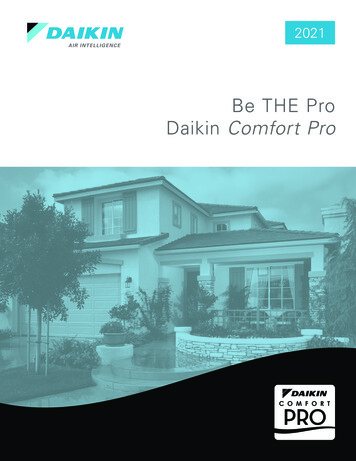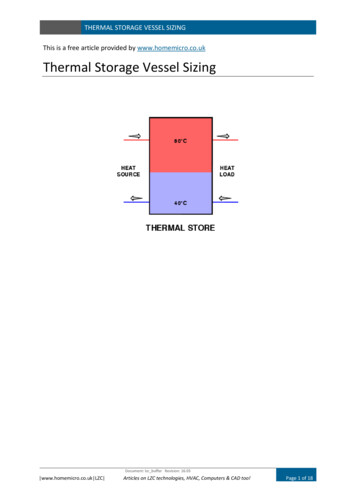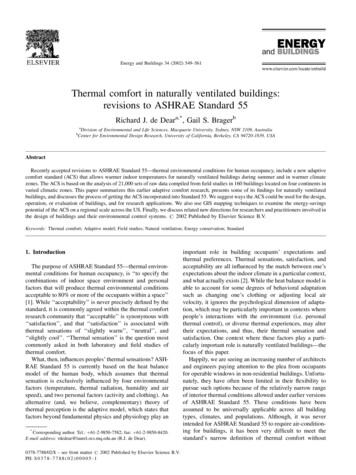
Transcription
Energy and Buildings 34 (2002) 549–561Thermal comfort in naturally ventilated buildings:revisions to ASHRAE Standard 55Richard J. de Deara,*, Gail S. BragerbabDivision of Environmental and Life Sciences, Macquarie University, Sydney, NSW 2109, AustraliaCenter for Environmental Design Research, University of California, Berkeley, CA 94720-1839, USAAbstractRecently accepted revisions to ASHRAE Standard 55—thermal environmental conditions for human occupancy, include a new adaptivecomfort standard (ACS) that allows warmer indoor temperatures for naturally ventilated buildings during summer and in warmer climatezones. The ACS is based on the analysis of 21,000 sets of raw data compiled from field studies in 160 buildings located on four continents invaried climatic zones. This paper summarizes this earlier adaptive comfort research, presents some of its findings for naturally ventilatedbuildings, and discusses the process of getting the ACS incorporated into Standard 55. We suggest ways the ACS could be used for the design,operation, or evaluation of buildings, and for research applications. We also use GIS mapping techniques to examine the energy-savingspotential of the ACS on a regional scale across the US. Finally, we discuss related new directions for researchers and practitioners involved inthe design of buildings and their environmental control systems. # 2002 Published by Elsevier Science B.V.Keywords: Thermal comfort; Adaptive model; Field studies; Natural ventilation; Energy conservation; Standard1. IntroductionThe purpose of ASHRAE Standard 55—thermal environmental conditions for human occupancy, is ‘‘to specify thecombinations of indoor space environment and personalfactors that will produce thermal environmental conditionsacceptable to 80% or more of the occupants within a space’’[1]. While ‘‘acceptability’’ is never precisely defined by thestandard, it is commonly agreed within the thermal comfortresearch community that ‘‘acceptable’’ is synonymous with‘‘satisfaction’’, and that ‘‘satisfaction’’ is associated withthermal sensations of ‘‘slightly warm’’, ‘‘neutral’’, and‘‘slightly cool’’. ‘‘Thermal sensation’’ is the question mostcommonly asked in both laboratory and field studies ofthermal comfort.What, then, influences peoples’ thermal sensations? ASHRAE Standard 55 is currently based on the heat balancemodel of the human body, which assumes that thermalsensation is exclusively influenced by four environmentalfactors (temperature, thermal radiation, humidity and airspeed), and two personal factors (activity and clothing). Analternative (and, we believe, complementary) theory ofthermal perception is the adaptive model, which states thatfactors beyond fundamental physics and physiology play an*Corresponding author. Tel.: þ61-2-9850-7582; fax: þ61-2-9850-8420.E-mail address: rdedear@laurel.ocs.mq.edu.au (R.J. de Dear).0378-7788/02/ – see front matter # 2002 Published by Elsevier Science B.V.PII: S 0 3 7 8 - 7 7 8 8 ( 0 2 ) 0 0 0 0 5 - 1important role in building occupants’ expectations andthermal preferences. Thermal sensations, satisfaction, andacceptability are all influenced by the match between one’sexpectations about the indoor climate in a particular context,and what actually exists [2]. While the heat balance model isable to account for some degrees of behavioral adaptationsuch as changing one’s clothing or adjusting local airvelocity, it ignores the psychological dimension of adaptation, which may be particularly important in contexts wherepeople’s interactions with the environment (i.e. personalthermal control), or diverse thermal experiences, may altertheir expectations, and thus, their thermal sensation andsatisfaction. One context where these factors play a particularly important role is naturally ventilated buildings—thefocus of this paper.Happily, we are seeing an increasing number of architectsand engineers paying attention to the plea from occupantsfor operable windows in non-residential buildings. Unfortunately, they have often been limited in their flexibility topursue such options because of the relatively narrow rangeof interior thermal conditions allowed under earlier versionsof ASHRAE Standard 55. These conditions have beenassumed to be universally applicable across all buildingtypes, climates, and populations. Although, it was neverintended for ASHRAE Standard 55 to require air-conditioning for buildings, it has been very difficult to meet thestandard’s narrow definition of thermal comfort without
550R.J. de Dear, G.S. Brager / Energy and Buildings 34 (2002) 549–561such mechanical assistance, even in relatively mild climaticzones. Needless to say the energy costs of providing thisconstant supply of uniformly conditioned, cool, still and dryair are significant, as are the well-known environmentalconsequences associated with this vast energy end-use.How can thermal comfort standards play a role in facilitating the appropriate use of energy-efficient, climateresponsive building design strategies? The first step mustbe to recognize that comfort depends on context. Peopleliving year-round in air-conditioned spaces are quite likelyto develop high expectations for homogeneity and cooltemperatures, and may become quite critical if thermalconditions in their buildings deviate from the center ofthe comfort zone they have come to expect. In contrast,people who live or work in naturally ventilated buildingswhere they are able to open windows, become used tothermal diversity that reflects local patterns of daily andseasonal climate variability. Their thermal perceptions—both preferences as well as tolerances—are likely to extendover a wider range of temperatures than are currentlyreflected in the old ASHRAE Standard 55 comfort zone.As an organization representing and furthering the interests of the air-conditioning industry ASHRAE must becommended for acknowledging these subtle issues surrounding thermal perception. ASHRAE recently fundedresearch to quantify the difference between peoples’ thermalresponses in air-conditioned and naturally ventilated buildings. The outcome was a proposal for a new adaptivecomfort standard to complement the traditional PMV-basedcomfort zone. This paper briefly describes and expands onthe results of that project, ASHRAE RP-884: developing anadaptive model of thermal comfort and preference, anddescribes how the work was recently incorporated intoASHRAE Standard 55, and how both practitioners andresearcher might apply the ACS. For greater detail aboutthe background research, previous papers describe theresults of our literature search on thermal adaptation [3],the specific procedures for developing the database [4], andour analysis methods and findings [5,6].2. Methods: developing the ASHRAE RP-884 databaseIn the mid-1980s, ASHRAE began funding a series offield studies of thermal comfort in office buildings spreadacross four different climate zones. They were specificallydesigned to follow a standardized protocol developed duringthe first in the series, ASHRAE RP-462 [7]. Since that timenumerous other thermal comfort researchers independentlyadopted the same procedures for collecting both physicaland subjective thermal comfort data in their own fieldstudies. In 1995, ASHRAE RP-884 began by collectingraw field data from various projects around the world thathad followed this standardized (or a similar) protocol, and/orwhere the data met strict requirements regarding measurementtechniques, type of data collected, and database structure.Standardized data processing techniques, such as methodsfor calculating clo and various comfort indices, were thenapplied consistently across the entire database [4]. Thisenabled RP-884 to assemble a vast, high-quality, internallyconsistent database of thermal comfort field studies. The RP884 database contains approximately 21,000 sets of raw datafrom 160 different office buildings located on four continents, and covering a broad spectrum of climate zones. Thelocations selected for the database and depicted in Fig. 1include Bangkok, Indonesia, Singapore, Athens, Michigan,several locations each in California, England, and Wales, sixcities in Australia (Darwin, Townsville, Brisbane, Sydney,Melbourne, Kalgoorlie) and five cities in Pakistan (Karachi,Quettar, Multan, Peshawa, Saidu). The data includes a fullrange of thermal questionnaire responses, clothing andmetabolic estimates, concurrent indoor climate measurements, a variety of calculated thermal indices, and concurrent outdoor meteorological observations.The buildings in the database were separated into thosethat had centrally-controlled heating, ventilating, and airconditioning systems (HVAC), and naturally ventilatedbuildings (NV). Since the RP-884 database comprises existing field experiments, this classification came largely fromthe original field researchers’ descriptions of their buildingsand their environmental control systems. The primary distinction between the building types was that the NV buildings had no mechanical air-conditioning, and the naturalventilation occurred through operable windows that weredirectly controlled by the occupants. In contrast, occupantsof the HVAC buildings had little or no control over theirimmediate thermal environment. Since most of the NVbuildings were studied in the summer, in most cases, thetype of heating system was irrelevant. The few that werestudied in winter may have had a heating system in operation, but it was of the type that permitted occupant control.Unfortunately, there were not enough hybrid ventilation(also called ‘‘mixed-mode’’) buildings in the RP-884 database to allow their separate analysis. All statistical analyseswere performed separately for the HVAC and NV buildings,using each individual building as the initial unit of analysis,and then conducting a meta-analysis of the separate statistical calculations done within each building. (see [5] fordetails of analyses).As noted earlier, the environmental inputs to conventionalheat-balance thermal comfort models (e.g. PMV) are alltaken from the indoor environment immediately surrounding the building occupants. These models also require theuser to have knowledge of the building occupants’ clothinginsulation and metabolic rates, which are often difficult toestimate in the field. But adaptive comfort models do thingsdifferently in that they use an outdoor thermal environmentalvariable as their input. Since presenting the early versions ofour adaptive models to the engineering and comfort researchcommunity in 1998, we have often been asked to explain therelevance of outdoor temperature to the prediction of thetemperature that people will find comfortable indoors. The
R.J. de Dear, G.S. Brager / Energy and Buildings 34 (2002) 549–561551Fig. 1. The geographic distribution of building studies comprising the RP-884 thermal comfort database that formed the basis of the adaptive model andadaptive comfort standard in this paper (map adapted from Rudloff [8]).question goes to the fundamental difference of approachbetween heat-balance and adaptive models of thermal comfort. The former account for thermal comfort in terms of themicroclimate immediately affecting the energy exchanges(i.e. heat balance) of the subject, whereas adaptive modelspredict comfort from broad-scale, contextual factors.But why outdoor climate? First, we believe that weatherand seasons exert a pervasive influence on our behavioraladaptations to the thermal environment. For example,we typically use information about expected maximumdaily temperatures along with recent experiences whenmaking decisions about what to wear on a particular day.Secondly, we think weather, both recent past and predictednear-future, along with longer-term seasonal swings determines our psychological adaptations in the form of thermalexpectations.But the matter of how to best characterize outdoor climateremains an interesting question in the comfort researchcommunity. One might presume daily outdoor temperaturesto be a more appropriate time-scale for use in predictingadaptive thermal comfort temperatures than monthlyaverages. Our choice of the latter was made on purelypragmatic grounds. Months represent the temporal scalemost commonly adopted by national weather bureaux forcollection and presentation of climatological normals. Sincethese form the basis of most engineering calculations theyare obviously more appropriate to an engineering standardsuch as ASHRAE Standard 55 than some shorter time-scale,despite the loss of resolution. As is often, the case whenmaking the transition from the researcher’s world to that ofthe practitioner, certain sacrifices in precision are necessaryin order to make models simple and useful to as many peopleas possible. Failure to make the sacrifice usually renders theresults of research of academic interest only—a fate sufferedby more than one thermal comfort model to date.3. Results: thermal comfort in naturally ventilatedbuildingsFig. 2a and b shows some of the most compelling findingsfrom our separate analysis of HVAC and NV buildings, inthe upper and lower panels, respectively. We believe that theclear differences in these patterns also vindicate our buildingclassification scheme. The graphs present a regression ofindoor comfort temperature1 for each building against meanoutdoor air temperature recorded for the duration of thebuilding study in question. Regressions were based only onbuildings that reached statistical significance (P ¼ 0:05) inthe derivation of their own neutral or preferred temperature.As a result, 20 buildings in the RP-884 database had to be1For this analysis, ‘‘preference’’ was considered as a more appropriateindicator of optimum thermal conditions than the traditional assumption of‘‘neutral thermal sensation’’. In the HVAC buildings, preferred temperaturewas slightly warmer than neutral temperatures in cooler climates, andslightly cooler in warmer climates (by up to 1 8C at either extreme end).There was
ASHRAE Standard 55, and how both practitioners and researcher might apply the ACS. For greater detail about the background research, previous papers describe the results of our literature search on thermal adaptation [3], the specific procedures for developing the database [4], and our analysis methods and findings [5,6]. 2. Methods: developing the ASHRAE RP-884 database In the mid-1980s .
